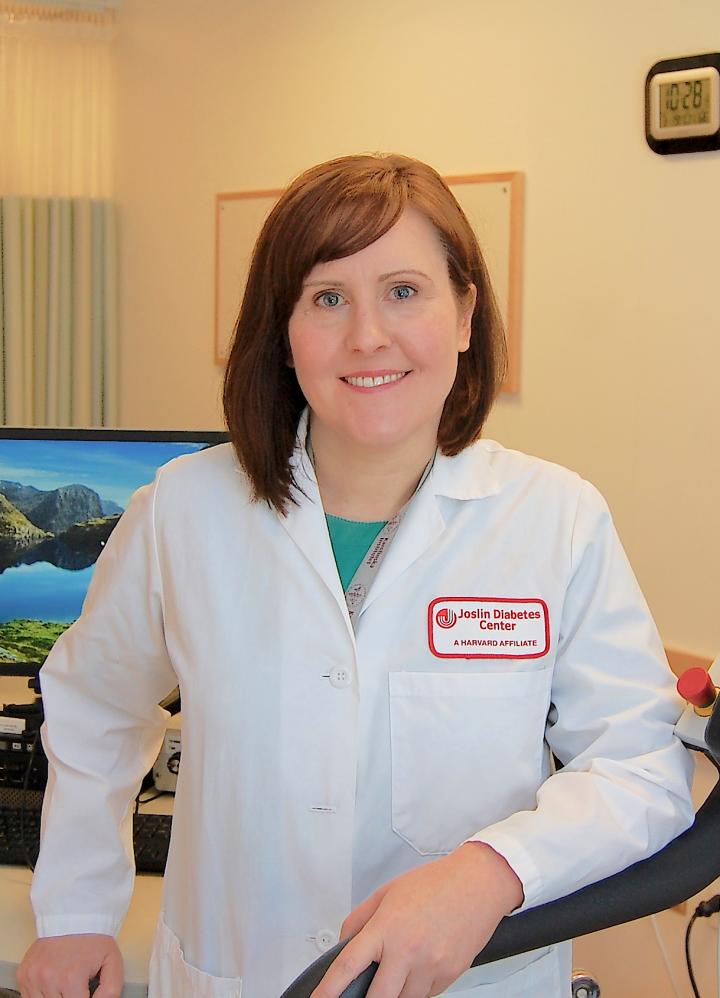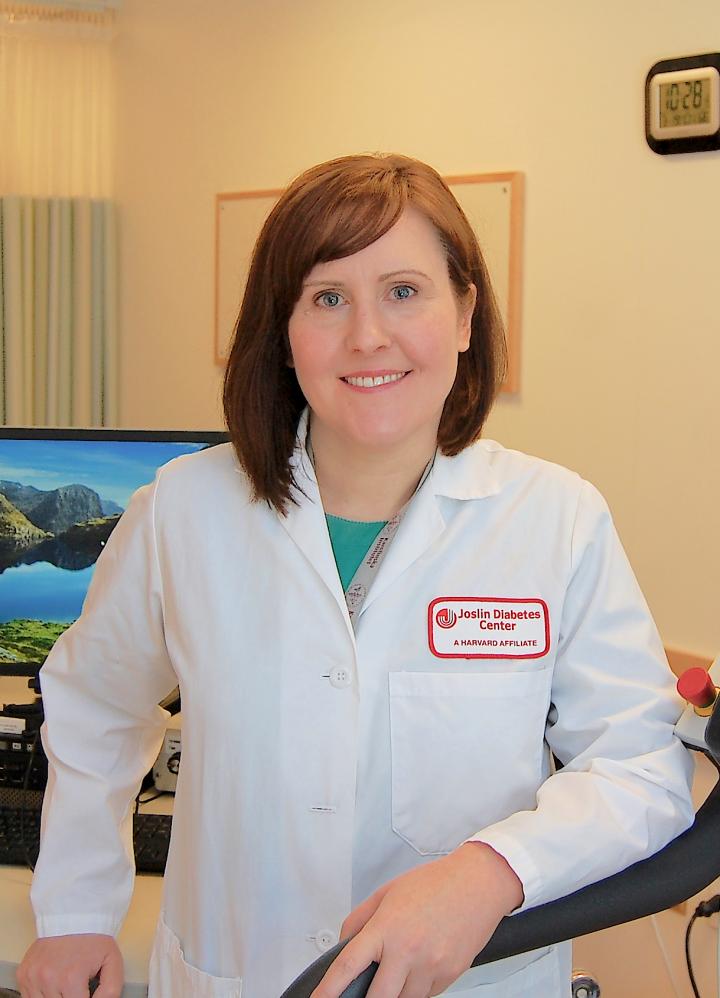
Credit: Joslin Diabetes Center Communications Office
BOSTON – (August 2, 2018) – Some people respond well to both aerobic exercise and strength training, while others don't. And some of us respond well to only one of those things, but not both. Scientists at Joslin Diabetes Center now have uncovered a surprising molecular "switch" that may help to explain why this happens.
"We've identified an exercise-activated biological pathway that hasn't been studied at all," says Sarah Lessard, PhD, an Assistant Investigator in Joslin's section of Clinical, Behavioral and Outcomes Research and first author on a paper presenting the research in the journal Nature Communications.
Studying lab animals and humans, Lessard and her colleagues discovered that a protein called c-Jun N-terminal kinase (JNK)helps to drive response to exercise. If JNK is activated during exercise, the researchers say, that stimulates skeletal muscle growth. If it's not activated, muscles improve their adaptation for endurance and aerobic capacity.
"It's like a switch," Lessard remarks. "If the switch is on, you'll have muscle growth. If it's turned off, you have endurance adaptation in the muscle."
Exercise is a foundation for our overall health, and exercise that promotes aerobic capacity is a powerful factor in preventing diabetes, cardiovascular disease and other chronic metabolic diseases. However, that capacity is not evenly distributed among us.
"If a hundred people do the exact same aerobic training program, some will have huge improvements in aerobic capacity, and some will have little to no response," Lessard notes. Her lab studies the biological signals that tell a muscle to adapt for aerobic capacity or for muscle growth.
In previous work, the Joslin team looked at which genes were activated in two groups of lab rats that had been bred for many generations to respond either very well or very poorly to endurance exercise training (running on treadmills). The scientists found that activation of the JNK biological pathway predicted that an animal would respond poorly to endurance exercise training.
That finding was a bit unexpected, since the researchers knew that JNK was associated with inflammation in metabolic diseases such as type 2 diabetes and obesity. So why would the protein be activated by exercise?
Lessard and her colleagues began their current study with mice that had been genetically modified to knock out production of JNK in their muscles. These "JNK knockout" mice remain perfectly healthy and will run vigorously on wheels in their cages very much like normal mice. ("Mice actually enjoy running several kilometers a night," Lessard remarks.)
But when both groups of mice were trained to run, the investigators found the JNK knockout mice had a much higher increase than normal mice in aerobic exercise capacity, along with higher levels of blood vessels and of a type of muscle fiber specialized to give endurance.
Next, the Joslin researchers ran an experiment that promotes muscle growth in animals. Normal mice doubled the mass of their affected muscles, but the JNK knockout mice didn't increase their muscle mass nearly as much.
Diving deeper into the biological mechanisms underlying these results, the scientists found that JNK works through a well-studied pathway involving myostatin, a protein that restrains muscle growth. Myostatin is targeted in some clinical trials that seek to increase muscle mass in aging and in diseases such as advanced cancer where muscle loss is often a serious problem.
The Joslin investigators then collaborated with Vernon Coffey, associate professor of exercise and sports science at Bond University in Gold Coast, Queensland, Australia, on tests in healthy, human volunteers. Results from Coffey's group indicated that similar biological mechanisms were at work.
The tests showed that JNK was highly activated in the muscles of humans lifting leg weights, a resistance exercise. In contrast, JNK generally was not activated in muscle when the volunteers performed cycling, an endurance exercise.
But a significant minority of test subjects did show some JNK activation in their leg muscles during endurance exercise. That activation might prevent endurance adaptations, and it might explain why some people don't respond as well to endurance exercise.
The Joslin team is looking at various ways to inhibit JNK activation. Among them, the scientists think that the activation of JNK during exercise depends on the amount of mechanical stress on the muscle, and that some people experience a higher level of mechanical stress during aerobic exercise. If so, developing approaches to reduce this stress might improve response.
Additionally, the researchers are doing experiments with animal models to try to treat this condition with drugs that inhibit JNK or related molecular targets.
The Joslin study has direct implications for the prevention of type 2 diabetes, the reduction of diabetes complications, and the prevention of cardiovascular disease. It could also prove useful for developing therapeutic approaches for building muscle to fight muscle-wasting diseases. (It also may help explain the "interference phenomenon" experienced by athletes during concurrent training.)
"We've begun to figure out how muscle decides whether it will grow or adapt for endurance, which really hasn't been known," Lessard sums up. "And we're finding that this process is directly linked to the risk of type 2 diabetes."
Lessard and her colleagues are now testing this hypothesis in a study analyzing the JNK biological pathway during endurance exercise, comparing people at heightened risk of type 2 diabetes versus people of normal risk.
If over-activation of the JNK pathway during endurance exercise does indeed boost the risk of diabetes, and if scientists can figure out a way to stop that process, "we might be able to reverse the risk in some people," Lessard speculates.
###
Joslin's Laurie Goodyear was senior author on the paper. Other Joslin co-authors included Tara MacDonald, Prerana Pathak and Michael Hirshman. Contributions also came from Roger Davis and Myoung Sook Han of the University of Massachusetts Medical School in Amherst; Vernon Coffey of Bond University; Johann Edge of Massey University in Palmerston North, New Zealand; and Donato Rivas of Tufts University in Boston. Lead funding for the research came from the American Heart Association and the National Institutes of Health.
About Joslin Diabetes Center
Joslin Diabetes Center is world-renowned for its deep expertise in diabetes treatment and research. Joslin is dedicated to finding a cure for diabetes and ensuring that people with diabetes live long, healthy lives. We develop and disseminate innovative patient therapies and scientific discoveries throughout the world. Joslin is an independent, non-profit institution affiliated with Harvard Medical School, and one of only 11 NIH-designated Diabetes Research Centers in the U.S.
For more information, visit http://www.joslin.org or follow @joslindiabetes
/>
Media Contact
Jeffrey Bright
[email protected]
@joslindiabetes
http://www.joslin.org





